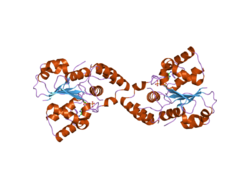Protein-coding gene in the species Homo sapiens
| SULT1C3 |
|---|
 |
| Available structures |
|---|
| PDB | Ortholog search: PDBe RCSB |
|---|
| List of PDB id codes |
|---|
2H8K, 2REO |
|
|
| Identifiers |
|---|
| Aliases | SULT1C3, ST1C3, sulfotransferase family 1C member 3 |
|---|
| External IDs | OMIM: 617151; MGI: 102928; HomoloGene: 56817; GeneCards: SULT1C3; OMA:SULT1C3 - orthologs |
|---|
| Gene location (Human) |
|---|
 | | Chr. | Chromosome 2 (human)[1] |
|---|
| | Band | 2q12.3 | Start | 108,239,968 bp[1] |
|---|
| End | 108,265,351 bp[1] |
|---|
|
| Gene location (Mouse) |
|---|
 | | Chr. | Chromosome 17 (mouse)[2] |
|---|
| | Band | 17 C|17 28.07 cM | Start | 54,268,643 bp[2] |
|---|
| End | 54,297,702 bp[2] |
|---|
|
| RNA expression pattern |
|---|
| Bgee | | Human | Mouse (ortholog) |
|---|
| Top expressed in | - testicle
- duodenum
- mucosa of transverse colon
- rectum
- gastric mucosa
- body of stomach
- mucosa of esophagus
- kidney
- prostate
- human kidney
|
| | Top expressed in | - olfactory epithelium
- retinal pigment epithelium
- trachea
- conjunctival fornix
- zygote
- secondary oocyte
- submandibular gland
- primary oocyte
- sexually immature organism
- hippocampal formation
|
| | More reference expression data |
|
|---|
| BioGPS | |
|---|
|
| Gene ontology |
|---|
| Molecular function | - alcohol sulfotransferase activity
- aryl sulfotransferase activity
- sulfotransferase activity
- transferase activity
| | Cellular component | | | Biological process | - sulfur compound metabolic process
| | Sources:Amigo / QuickGO |
|
| Orthologs |
|---|
| Species | Human | Mouse |
|---|
| Entrez | | |
|---|
| Ensembl | | |
|---|
| UniProt | | |
|---|
| RefSeq (mRNA) | | |
|---|
| RefSeq (protein) | | |
|---|
| Location (UCSC) | Chr 2: 108.24 – 108.27 Mb | Chr 17: 54.27 – 54.3 Mb |
|---|
| PubMed search | [3] | [4] |
|---|
|
| Wikidata |
| View/Edit Human | View/Edit Mouse |
|
Sulfotransferase 1C3, also known as ST1C3, is an enzyme that in humans is encoded by the SULT1C3 gene.[5][6][7]
Function
Sulfotransferase enzymes catalyze the sulfate conjugation of many hormones, neurotransmitters, drugs, and xenobiotic compounds. These cytosolic enzymes are different in their tissue distributions and substrate specificities. The gene structure (number and length of exons) is similar among family members.[5]
Clinical significance
ST1C3 sulfates large benzylic alcohols such as 1-hydroxymethyl-pyrene to chemically reactive mutagenic sulpho conjugates.[8]
See also
References
- ^ a b c GRCh38: Ensembl release 89: ENSG00000196228 – Ensembl, May 2017
- ^ a b c GRCm38: Ensembl release 89: ENSMUSG00000023943 – Ensembl, May 2017
- ^ "Human PubMed Reference:". National Center for Biotechnology Information, U.S. National Library of Medicine.
- ^ "Mouse PubMed Reference:". National Center for Biotechnology Information, U.S. National Library of Medicine.
- ^ a b "Entrez Gene: sulfotransferase family".
- ^ Freimuth RR, Wiepert M, Chute CG, Wieben ED, Weinshilboum RM (2004). "Human cytosolic sulfotransferase database mining: identification of seven novel genes and pseudogenes". Pharmacogenomics J. 4 (1): 54–65. doi:10.1038/sj.tpj.6500223. PMID 14676822. S2CID 17481502.
- ^ Allali-Hassani A, Pan PW, Dombrovski L, Najmanovich R, Tempel W, Dong A, Loppnau P, Martin F, Thornton J, Thonton J, Edwards AM, Bochkarev A, Plotnikov AN, Vedadi M, Arrowsmith CH (May 2007). "Structural and chemical profiling of the human cytosolic sulfotransferases". PLOS Biol. 5 (5): e97. doi:10.1371/journal.pbio.0050097. PMC 1847840. PMID 17425406.
- ^ Meinl W, Donath C, Schneider H, Sommer Y, Glatt H (April 2008). "SULT1C3, an orphan sequence of the human genome, encodes an enzyme activating various promutagens". Food Chem. Toxicol. 46 (4): 1249–56. doi:10.1016/j.fct.2007.08.040. PMID 17936463.
External links
- PDBe-KB provides an overview of all the structure information available in the PDB for Human Sulfotransferase 1C3 (SULT1C3)


















